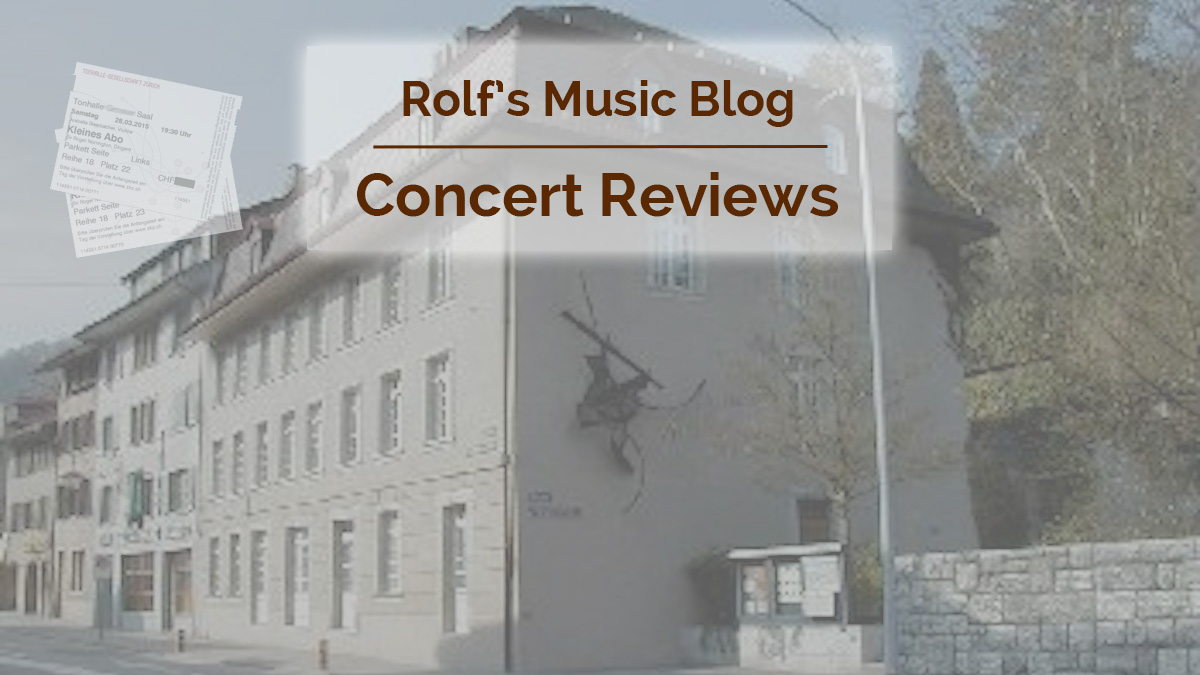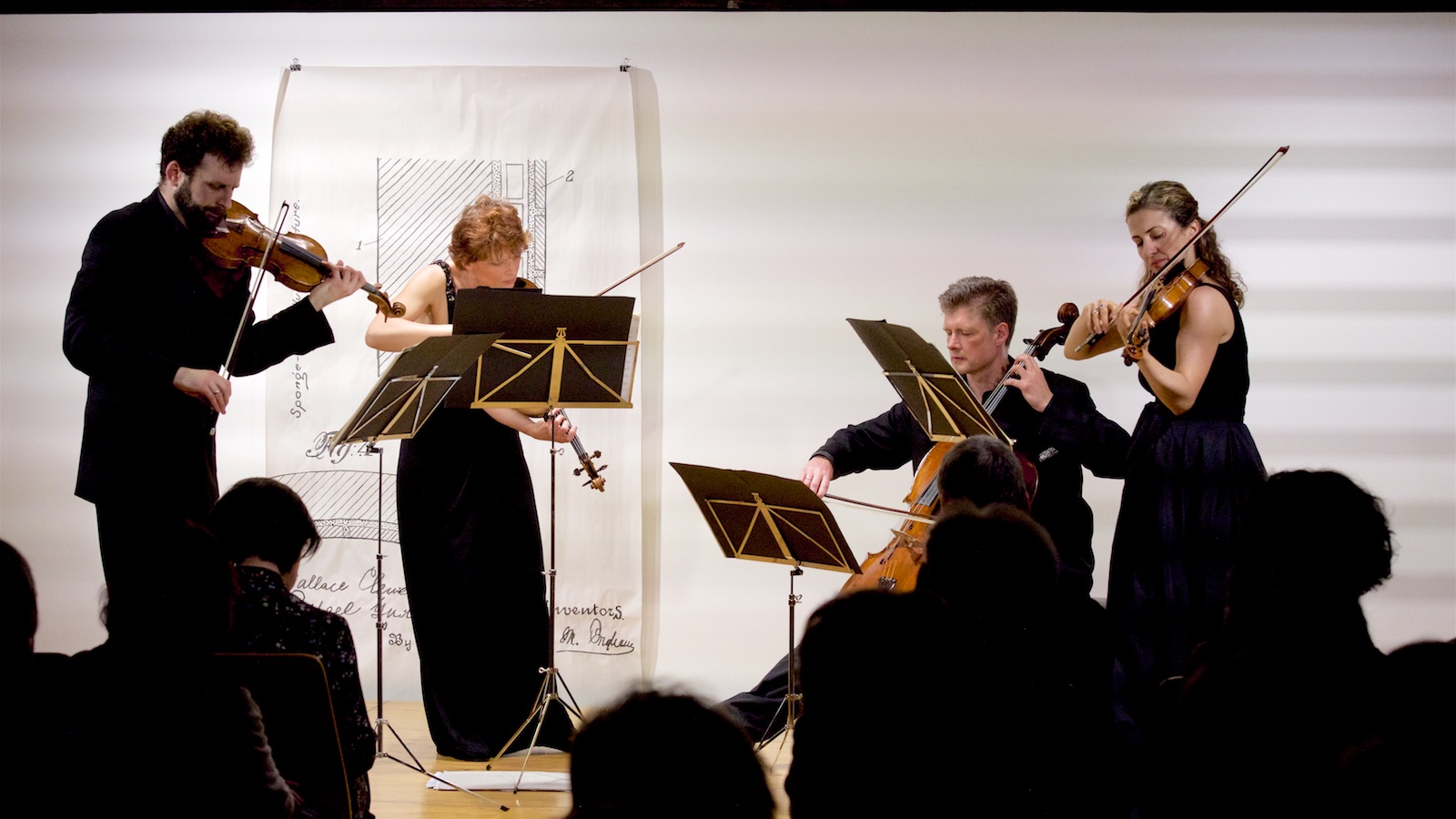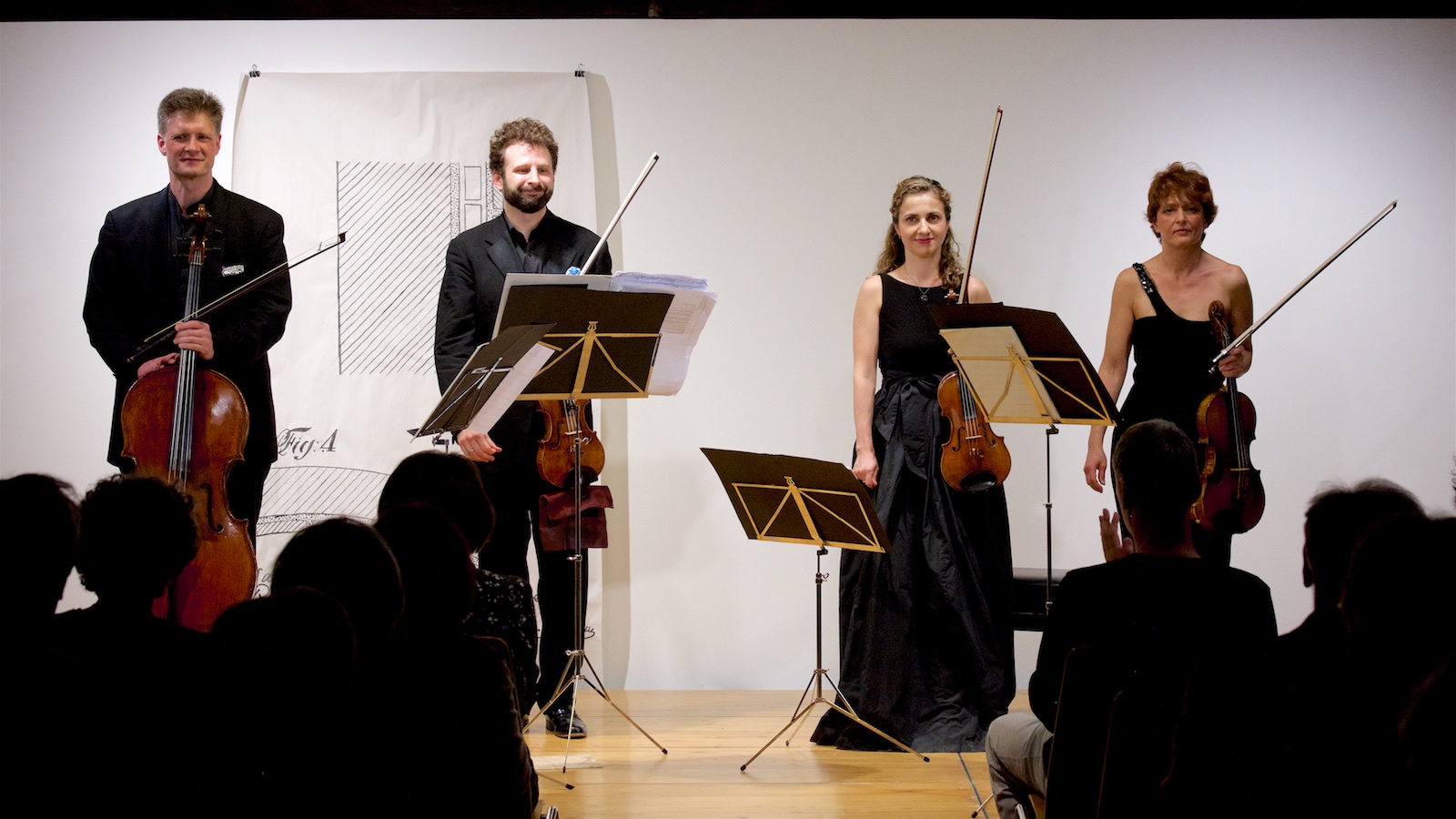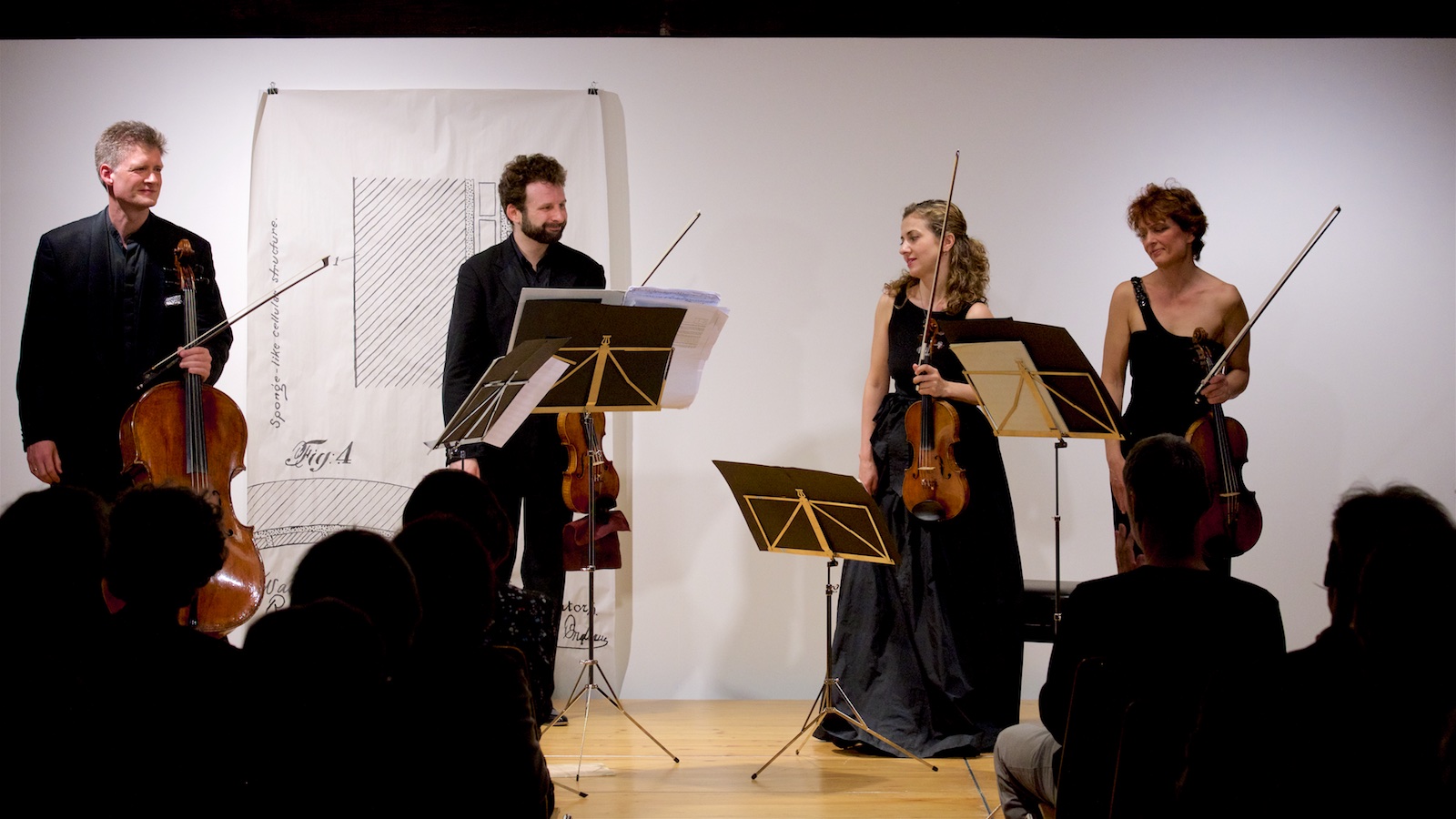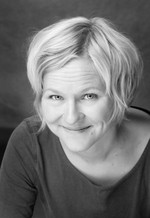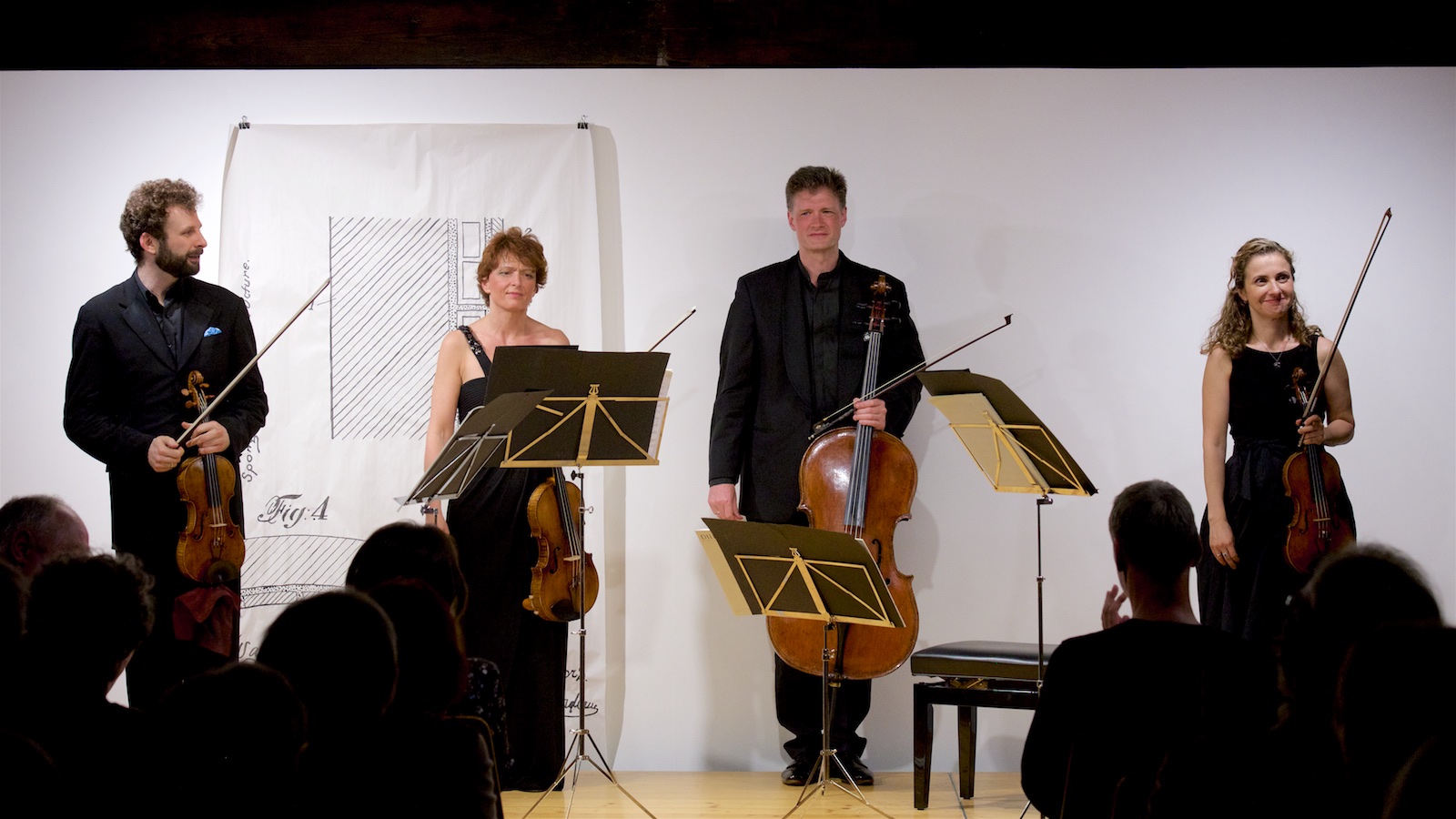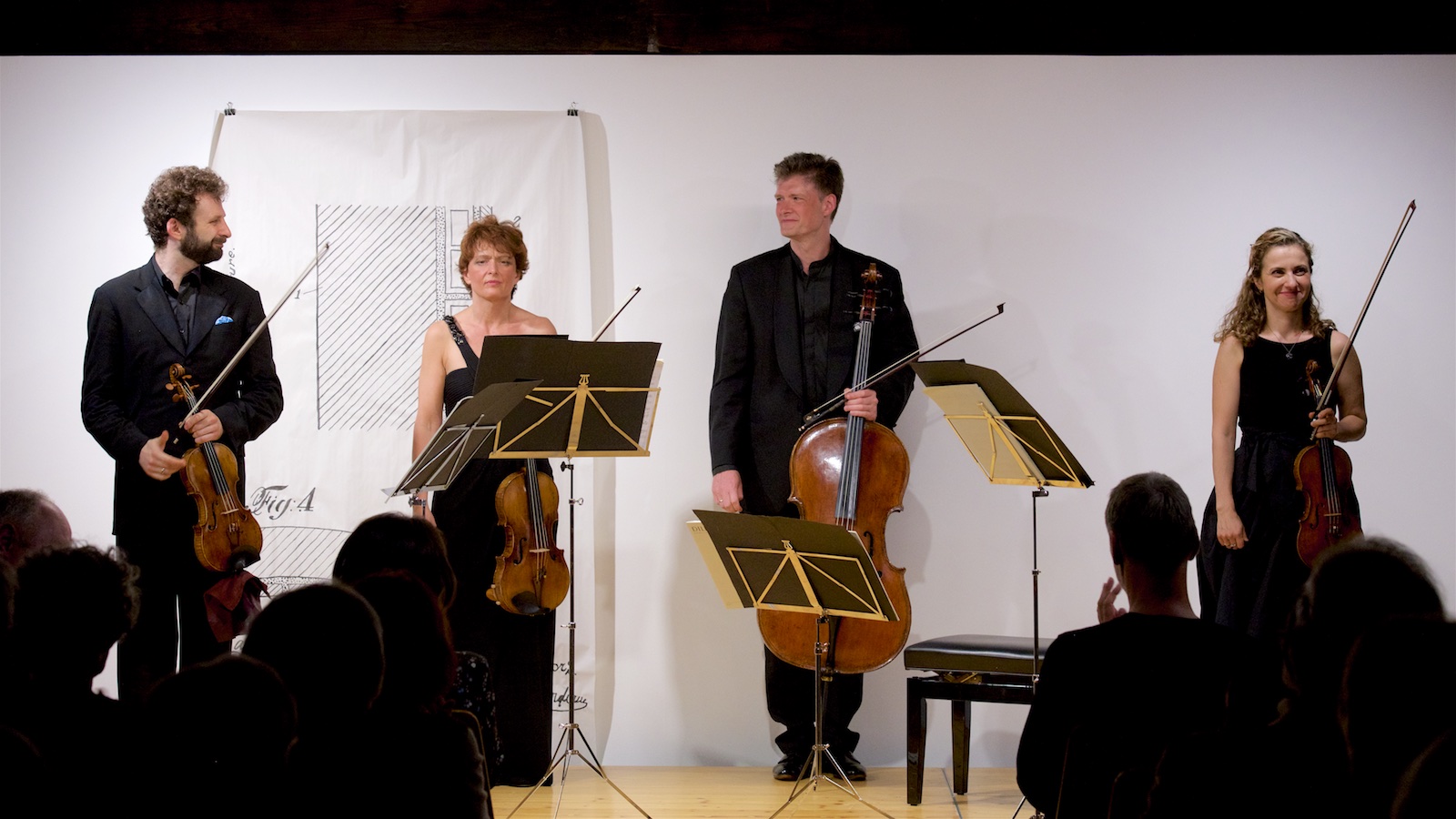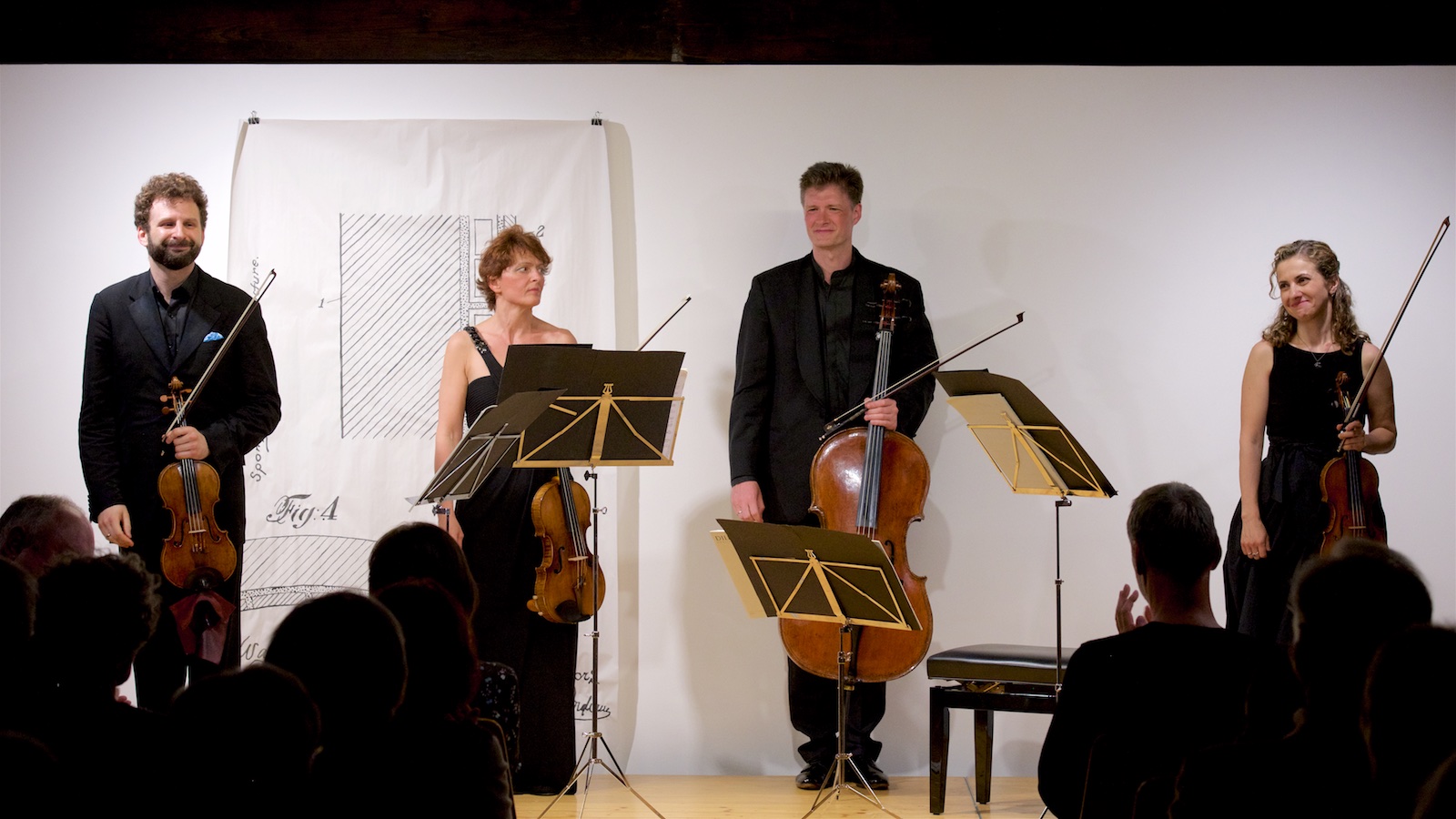Gringolts Quartet
Haydn / Wennäkoski / Beethoven
Zimmermannhaus, Brugg / AG, 2018-05-05

2018-05-09 — Original posting
2018-05-09 — Minor amendments based on input by Ilya Gringolts
Table of Contents
Introduction — Venue, Artists
After a concert on 2016-10-29, this is my second visit to the Zimmermannhaus in Brugg, a historic building that holds both an art gallery, as well as a small concert hall (for just around 100 people) under the roof. The hall wasn’t quite sold out this time (maybe the weather was too nice?). The walls were decorated with graphics from the current arts exhibition (most of which was in the floor below the concert hall). My wife and I had seats in the rear, at the central corridor (with the advantage that I could get up and take some photos during the applause and during the encore). In this small venue, all seats are acoustically more or less equivalent (except perhaps for the first three rows, where the acoustic impression is likely not as balanced as from the rear seats).
About the Artists
The Gringolts Quartet consists of the following members:
- Ilya Gringolts, violin by Giuseppe Guarneri “del Gesù”, Cremona 1742/1743
- Anahit Kurtikyan, violin by Camillo Camilli, Mantova, 1733
- Silvia Simionescu, viola by Jacobus Januarius (Giacomo Gennaro), Cremona, 1660
- Claudius Herrmann, cello by Maggini, Brescia, 1600
Just like with the venue, this is a déjà vu, as I have encountered this ensemble before. On 2017-04-21, they gave a concert in the LAC in Lugano, which I still remember well and very much enjoyed (this earlier concert report contains additional information on the artists). Enough for me not to miss the opportunity to hear the ensemble again!
Setup
The quartet played in a somewhat unusual setup with the two violins at the front (Ilya Gringolts on the left, Anahit Kurtikyan on the right), Silvia Simionescu playing the viola behind the first violin (rear left), and Claudius Herrmann on the right-side rear seat. Further, unlike in the concert last year (and unlike the vast majority of string quartet ensembles), the violins and the viola were playing standing. It’s hard, if not impossible for outsiders to tell what difference that makes. In theory, I should be able to tell now, as I have heard these artists playing both sitting (2017-04-21 in Lugano) and standing (now). However, the two situations are a year apart, and the repertoire is not the same, nor is the venue, the acoustics, etc.: as the report below will show, the two concerts were simply both excellent.
Instrument Types
For as much as I could tell, all instruments have undergone modernization, i.e., they have the same longer and steeper fingerboard, slightly longer neck, and higher string tension as typical (ubiquitous) modern string instruments. One may deplore this, but with truly baroque string instruments, modern repertoire would hardly be playable. For the most part, the modernization affects the volume, rather than the tone quality. For the latter, using gut strings (and possibly tuning to a’=415 Hz) would still be helpful. Ilya Gringolts used gut G and D strings, Anahit Kurtikyan played on gut G, D, and A strings [Many thanks to Ilya Gringolts for information on the strings!]. Gut E strings are barely an option on modern (or modernized) violins, due to the larger tension.
Bows
For both the articulation and the tone quality, the bow (along with the way in which one uses it) can be as important as the strings / the instrument. In the Haydn quartet, the ensemble used shorter classical bows (Claudius Herrmann even used a baroque bow), rather than the long, modern “Tourte” type bows. For the Beethoven, the ensemble (except for the cellist) used classical or transitional bows. [Many thanks to Ilya Gringolts for extra information on this!]
With the baroque, classical (or transitional) bow, the artist applies less pressure. More important in many cases is the length of the modern bow. It allows for long, uninterrupted tones. At the same time, it brings a certain danger (even a tendency, with some) to apply “Nachdrücken” when accelerating the bow towards the end of a note (to reach the end of the bow). I can happily say that I did not even hear a hint of Nachdrücken in this concert!
Haydn: String Quartet in G major, op.76/1, Hob.III/75
Franz Joseph Haydn (1732 – 1809) composed his last collection of 6 String Quartets, op.76, the so-called “Erdödy” quartets, in 1796/1797. After this, he only published two additional quartets, op.77 (the “Lobkowitz” quartets), in 1799, followed by a fragment from 1803, which was later published as op.103. The op.76 includes the following quartets:
- No.1 in G major, op.76/1
- No.2 in D minor, op.76/2, “Fifths”
- No.3 in C major, op.76/3, “Emperor”
- No.4 in B♭ major, op.76/4, “Sunrise”
- No.5 in D major, op.76/5
- No.6 in E♭ major, op.76/6
All these quartets feature four movements; in the case of String Quartet in G major, op.76/1, Hob.III/75, these are
- Allegro con spirito
- Adagio sostenuto
- Menuetto: Presto – Trio
- Allegro ma non troppo
Less than a month ago, I attended a concert in Zurich (2016-04-08) where No.4 of the above quartet group (String Quartet in B♭ major, op.76/4, “Sunrise”) was performed.
The Performance
After this concert, I have been looking through my notes. I compared them with my review from the concert in Lugano on 2017-04-21. Oddly (or luckily), I find that I have used the same words, the same descriptive terms now as in my existing review. That’s a good thing, meaning that in my perception this concert was as good as the previous one. On the other hand, it means that this report either repeats stuff from last year’s comment, or otherwise it may appear to have “holes”, to be thin in comments where I don’t want to use the same words again (in which case you can assume that the earlier report is as valid as this one, and that it applies to this concert as well).
I. Allegro con spirito
Already the three opening chords effectively set the stage—not just for the composition, but even more so for the performance. Here, this was not the grandiloquent, full-sounding “Here we are!” that one can hear from other ensembles. Rather, proper f (not ff), and proper staccato: dry, not a big statement, more of an opening question to which the cellist started responding immediately, with clear, light articulation, and essentially without vibrato. Yet the performance was full of Klangrede in the best sense of the word, through articulation / phrasing and careful, “talking” dynamics. The other instruments follow suit, and the exposition also shows that the ensemble extends Klangrede to lively agogics, especially in the second theme (bars 33ff). This even intensified in the development part: agogics with “grip”!
As already in the concert last year, I found that these are four voices full of character, each with its specifics, yet perfectly matching in their expression. Of course, that’s only partially a question of instrument quality, but mostly one of the abilities of the individual artists, and the mutual agreement between them.
I was pleased to realize that the group repeated not only the exposition, but also the second part, development + recapitulation.
★★★★★
II. Adagio sostenuto
Wonderful, subtle playing, with finest details in agogics and dynamics, especially in the area of p and pp. A performance full of life even within single tones, never losing the tension: quite to the contrary, the suspense increased towards the second half, where one could almost touch it in the general rests! And all this with a minimum in vibrato! I was totally carried away by this movement & interpretation!
★★★★★
III. Menuetto: Presto – Trio
Playful, light, but fast and virtuosic—and with “bite” in the articulation: expressive, anything but characterless, polished perfection. The Trio was distinctly slower: a somewhat earthy, swaying, living peasant dance, a stark contrast to the Menuetto—altogether simply excellent! I noted the ensemble’s alertness, most visible on the right-hand side of the quartet (Claudius Herrmann, Anahit Kurtikyan).
★★★★★
IV. Allegro ma non troppo
Very virtuosic, rather fast, but nevertheless with distinct, excellent, “speaking” agogics. This movement in particular gave me the impression of four musicians who are absolutely equivalent in their virtuosity, their instrumental abilities and musicality, but also in their relative weight within the ensemble. There was (is) no “prima donna“, no one trying to dominate or to control the others. If the wonderful, full sound of Claudius Herrmann’s Maggini cello was standing out at times, drawing extra attention, then that’s in the nature of things: in the composition, the size and volume of the instrument, and the fact that the cello sets itself apart from violins and viola from the tonal range alone.
The exposition (with repeat) was predominantly (highly) virtuosic, even speeding up towards the double bar. The atmosphere changed with development part. There was a sudden melancholic, lyrical tone (without too much of a tempo change), retracting into a pensive moment even (p and pp in bars 94 – 104), followed by a defiant sforzato section. After a fermata, the atmosphere turned very intimate and lovely at once, for a solo (almost a cadenza) in the first violin. The virtuosity grew again—just to revert to a playful pizzicato ending / Coda. Fascinating—both the music, as well as the performance!
★★★★★
Conclusion
A memorable, world-class / top performance, by all means! I could maybe think of two other ensembles that would be / come close to this. However, the Gringolts Quartet is hard to beat! Of course, if you are a friend of polished perfection, of full-sounding legato playing, full of romanticisms (vibrato everywhere, portamenti, etc.), this would be a different matter altogether. However, I strongly prefer a performance such as this one, which closely follows the composer’s footsteps, i.e., which tries reconstructing the soundscape that the composer must have had in mind.
Overall rating: ★★★★★
Lotta Wennäkoski: Culla d’Aria (2003/2004)
The Finnish composer Lotta Wennäkoski was born 1970 in Helsinki (see Wikipedia for additional information). She started publishing compositions in 2003. So, Culla d’Aria from 2003/2004 is among her first published works. It’s her first composition for string quartet, lasting around 10 minutes, according to her Web site.
“Culla d’aria” translates to “cradle of air”. The title is all information I had about the composition. I pictured situations such as “let air be a (my?) cradle”, “be surrounded and carried by air”, “swaying in the wind”, etc. …
The Performance
The piece started with—nothing! Did it even start, or has it been there “forever”? Concrete: from the back of the hall, one could see Anahit Kurtikyan gently move the bow over the strings. However, there wasn’t the slightest sound (even though the air conditioning had been switched off). Then, the viola joined in, with whispered tones in the finest ppppp, followed by the other instruments, calm breathing in the softest tones. Was it maybe rather more memories of tones, sounds? Breathing or the gentle sound of Aeolian harps?
The breathing gradually intensified. Sounds of nature, glissando, bows hushing over the strings, to and fro, occasional, strong gusts of wind, perhaps? Eerie noises (sul ponticello, even behind the bridge). Motifs from two, then three, then more tones, melody fragments. After another, silent breathing, meditative breathing episode, “burr” sounds from bouncing bows, a polyphonic mix of motifs, ostinato tones in the cello, growing into a dense web of acoustic interaction, tonal insofar as it all related to the base in the cello (in this segment). I pictured a cradle swaying in the wind, surrounded by a crows of dwarfs / nature spirits, which gradually vanished, leaving again the whispering of the wind, and the cradle swinging forth and back…
Conclusion
For me as a listener, this was a very interesting, meditative & imaginative composition. Fascinating music which I think strongly relates to nature in Finland, with wind, trees, the play of light and shadow. It totally caught and held my attention! Utmost attentiveness was very obvious also among the musicians. I suspect that between the scarce rhythmic structure and the complexity of the notation for such unusual soundscapes, this isn’t easy on the ensemble! And again, it was obvious that the members of the ensemble treated themselves as collective of four individuals with equal rights: any member can take over control & initiative, as required. And intonation issues are simply non-existent, even in such music!
The quartet’s performance felt absolutely compelling to me, as did Lotta Wennäkoski’s composition (I haven’t listened to a reference recording, though).
Rating: ★★★★★
Beethoven: String Quartet No.12 in E♭ major, op.127
Ludwig van Beethoven (1770 – 1827) wrote 16 “main” string quartets. Among these, String Quartet No.12 in E♭ major, op.127, is a creation from 1825. It features four movements:
- Maestoso (2/4) – Allegro (3/4)
- Adagio, ma non troppo e molto cantabile (12/8) – Andante con moto (4/4) – Adagio molto espressivo (2/2) – Tempo I (12/8)
- Scherzando vivace (3/4) / Allegro (2/4) — Presto (3/4) – Tempo I (3/4)
- Finale (2/2) – Allegro con moto (6/8)
I have posted an extensive comparison of recordings of this quartet, in a post which includes score samples and other, additional information. So, I won’t spend more words on the composition here.
The Performance
Was this a coincidence or conscious planning? Both the Haydn quartet, as well as Beethoven’s op.127 start with a fanfare-like “statement”! And both may be “abused” to draw the listener’s attention with a powerful (excessively powerful), sonorous signal!
I. Maestoso – Allegro
As already with the Haydn quartet, the entry into this movement was not a powerful fanfare, not the start to a drama. It was rather an opening question, when the Maestoso ends with a trill on the subdominant stage: the tones were played portato, clearly separated, not stretched to (almost) legato, as often the case in traditional performances.
In the Allegro, there were again those expressive, detailed dynamics, distinct agogics—Klangrede at its best. The articulation was clear, always differentiating between legato, portato and staccato. The ensemble didn’t shy away from dramatic accelerando as expressive means (e.g., in the ff at bar 121ff). And as already in the Haydn quartet, vibrato is used selectively only, for highlighting specific notes or parts of a phrase.
It wasn’t a performance aiming at beautiful, let alone perfect sound—but it was alive! More than that: Beethoven was alive here!!!
★★★★★
II. Adagio, ma non troppo e molto cantabile – Andante con moto – Adagio molto espressivo – Tempo I
What a beginning: merely whispered, all pppp in the first tones—and then so utterly expressive and touching, yet never even a trace larmoyant! It felt as if the composer had been among us, his heart bleeding in deep, sincere emotion! The music was entirely introspective, just atmosphere and emotion. Nothing was exaggerated, nothing “made up”. And the playing with (often) very little vibrato highlighted the long dissonances that seemed to tear the composer’s heart apart!
In the Andante con moto, the composer appeared to have diverted into a clearer mood, the atmosphere was almost playful. Was there maybe even a trace of irony? One voice picked up a melody, the others gradually joined in, forming a lively conversation among four equal minds. The atmosphere suddenly changed again, turning pensive, melancholic, hesitant. The artists exposed the dissonances, the sometimes eerie sounds, didn’t try making this rather painful segment sound “nice”.
When the tempo I returned, the vibrato occasionally was very emotional, especially around the expressive climax. I found it admirable how Ilya Gringolts occasionally left his voice step into the background, giving precedence to the others.
To me, this is one of Beethoven’s most demanding, most challenging quartet movements—not technically, but from the point-of-view of interpretation. Other movements may go farther in the depth of the emotion; here, the difficulty is to “keep the piece together”, to form a compelling entity.
★★★★½
III. Scherzando vivace / Allegro – Presto – Tempo I
Very forward-moving, a relatively fast tempo. However, very poignant and accurate in the articulation, again with focus on expression, not polished, perfect sound. Alert playing, full of tension, with the cello as the lead voice: excellent! The ff segment (bars 61ff) had the rhythm reinforced with pounding beats. In the short Allegro inserts, the tension grew to real suspense…
The Presto part was blazingly fast, completely ignoring the aspect of sound quality or esthetics, but again with distinct rubato / agogics. And here it was again, this feeling that I had a year ago: an ensemble playing as if it was a matter of life and death! Or was it rather (or also) the composer going through the extremes of life and death?
★★★★★
IV. Finale – Allegro con moto
A movement that alternates between (almost) gently swaying rhythm and segments with vehement, almost furious, heavy f(orzato) pounding. The ensemble again used agogics to highlight the changes in character: the use of tempo (changes / alterations) was free, but never inappropriate. And again, I found it amazing how Ilya Gringolts was willing to step back behind the other voices, where this seemed appropriate: such a change from many (most) other string quartet ensembles!
The transition to the Allegro con moto part was a move into another world, a world beyond maybe. There were eerie sounds at first, gradually turning into a truly jubilant, joyful ending: not boisterous, though—especially not in this interpretation, where the final chords were deliberately moderated, consciously placed and articulated. The entire movement shows Beethoven at the peak of his creative, ingenious power: a masterful work in a masterful interpretation!
★★★★★
Conclusion
Sound esthetics: similar to their interpretation of the Haydn quartet above, the Gringolts Quartet was never aiming for perfection, for a flawless, high-polish performance: it’s expression which counts. And, even more so, of course, the composer’s intent, as we now understand it from the score. I’m sure perfection would have been the least of Beethoven’s concerns, had he been able to hear this music in a real performance (as opposed to just his inner ear). The performance by the Gringolts Quartet simply left me speechless and deeply moved.
My ratings are superlative almost throughout. This is all the more astounding, as Anahit Kurtikyan had to take a time-out of a few minutes after the second Beethoven movement: it had been rather warm in the hall (with the air conditioning switched off for a lower noise level). Playing while standing probably is more strain than playing in a chair—or maybe she just didn’t feel well during the second half of the concert?
Interestingly, her performance gave very little, if any indication about her feeling sick. One had to watch really careful to guess that maybe she was a trace more careful, more restrained, perhaps seeking eye contact with the others more often than otherwise. The fact that these problems remained largely hidden, and that she returned to stage to finish the concert deserves highest respect! During the applause, she even indicated that she was ready to play the encore, see below.
Overall rating: ★★★★★
Encore — Dvořák: No.9 from “Cypresses” (Cypřiše) for String Quartet, B.152
In 1865, Antonín Dvořák (1841 – 1904) composed 18 love songs, published under the title “Cypresses” (Cypřiše), B.11, based on poems by Gustav Pfleger Moravský (1833 – 1875). 1887, 22 years later, Dvořák arranged 12 of these songs (Nos. 2-4, 6-9, 12, 14, and 16-18) for string quartet. He published these under the same name, “Cypresses” (Cypřiše) for String Quartet, B.152.
The ensemble “thanked the audience for staying for so long” (as if this had been a burden!) by playing one of the quartet arrangements of “Cypresses”, B.152: No.9. “Thou only dear one but for me” (Ó duše drahá jedinká), Moderato. In the original song cycle (B.11), this is No.4. It’s a warm, highly romantic song, murmuring (played con sordino), dreamy, intimate, cosy. It didn’t need to fit Beethoven’s op.127 (as that left a very string impression anyway), but it definitely was perfect as closing piece for this most memorable evening!
All concert photos: © Rolf Kyburz, all rights reserved

